Asymptotic Solution and Numerical Simulation of Lamb Waves in Functionally Graded Viscoelastic Film
Abstract
:1. Introduction
2. Basic Equation for Lamb Waves in FGVM Film
3. Power Series Solution
4. MMA Method and Optimization
4.1. MMA Method
4.2. Optimization of the MMA Method
5. Numerical Results and Discussion
5.1. Comparison with the Exact Analytical Results
5.2. Material Parameters Varying Linearly
5.2.1. All Material Parameters Varying Identically
5.2.2. Material Parameters Varying Independently
5.2.3. Relative Viscosity Coefficient Varying Independently
5.3. Influence of Gradient Parameter on Wave Attenuation
6. Conclusions
Author Contributions
Funding
Conflicts of Interest
References
- Achenbach, J.D. Wave Propagation in Elastic Solids; Tongji University Press: Shanghai, China, 1992; pp. 232–248. [Google Scholar]
- Lu, Y.; Zhu, Y.; Zhu, Z. The propagation of Lamb waves in a plate with viscoelastic layer coating. Acta Acust. 2006, 31, 355–362. [Google Scholar]
- Cao, X.S.; Jin, F.; Jeon, I. Calculation of propagation properties of Lamb waves in a functionally graded material (FGM) plate by power series technique. NDT E Int. 2011, 44, 84–92. [Google Scholar] [CrossRef]
- Amor, M.B.; Ghozlen, M.H.B. Lamb waves propagation in functionally graded piezoelectric materials by Peano-series method. Ultrasonics 2015, 55, 10–14. [Google Scholar] [CrossRef] [PubMed]
- Wu, X.H.; Shen, Y.P.; Sun, Q. Lamb wave propagation in magneto-electro-elastic plates. Appl. Acoust. 2007, 68, 1224–1240. [Google Scholar] [CrossRef]
- De Luca, A.; Caputo, F.; Khodaei, Z.S.; Aliabadi, M.H. Damage characterization of composite plates under low velocity impact using ultrasonic guided waves. Compos. Part B Eng. 2018, 138, 168–180. [Google Scholar] [CrossRef]
- De Luca, A.; Perfetto, D.; De Fenza, A.; Petrone, G.; Caputo, F. Guided waves in a composite winglet structure: Numerical and experimental investigations. Compos. Struct. 2019, 210, 96–108. [Google Scholar] [CrossRef]
- Koizumi, M. The concept of FGM. Ceram. Trans. FGM. 1993, 34, 3–10. [Google Scholar]
- Qian, Z.H.; Jin, F.; Lu, T.J.; Kishimoto, K. Transverse surface waves in functionally graded piezoelectric materials with exponential variation. Smart Mater. Struct. 2008, 17, 065005. [Google Scholar] [CrossRef]
- Cao, X.; Jin, F.; Jeon, I.; Lu, T.J. Propagation of Love waves in a functionally graded piezoelectric material (FGPM) layered composite system. Int. J. Solids Struct. 2009, 46, 4123–4132. [Google Scholar] [CrossRef] [Green Version]
- Kuo, H.Y.; Bhattacharya, K. Fibrous composites of piezoelectric and piezomagnetic phases. Mech. Mater. 2013, 60, 159–170. [Google Scholar] [CrossRef]
- Han, X.; Liu, G.R. Effects of SH waves in a functionally graded plate. Mech. Res. Commun. 2002, 29, 327–338. [Google Scholar] [CrossRef]
- Kiełczyński, P.; Szalewski, M.; Balcerzak, A.; Wieja, K. Propagation of ultrasonic Love waves in nonhomogeneous elastic functionally graded materials. Ultrasonics 2016, 65, 220–227. [Google Scholar] [CrossRef]
- Cao, X.S.; Jin, F.; Wang, Z.K. On dispersion relations of Rayleigh waves in a functionally graded piezoelectric material (FGPM) half-space. Acta Mech. 2008, 200, 247–261. [Google Scholar] [CrossRef]
- Yuan, L.; Shen, Z.H.; Ni, X.W.; Lu, J. Numerical calculation of laser induced surface wave in material with changes of near-surface properties. Infrared Laser Eng. 2007, 36, 328–331. [Google Scholar]
- Sun, H.X. Numerical simulation of laser-generated Rayleigh wave by finite element method on viscoelastic materials. Acta Phys. Sin. 2009, 58, 6344–6350. [Google Scholar]
- Cai, C.; Liu, G.R.; Lam, K.Y. A transfer matrix approach for acoustic analysis of a multilayered active acoustic coating. J. Sound Vib. 2001, 248, 71–89. [Google Scholar] [CrossRef]
- Du, J.K.; Ye, D. SH waves in laminated structure of functionally gradient piezoelectric material. J. Solid Rocket Technol. 2005, 28, 133–136. [Google Scholar]
- Collet, B.; Destrade, M.; Maugin, G.A. Bleustein–Gulyaev waves in some functionally graded materials. Eur. J. Mech. 2006, 25, 695–706. [Google Scholar] [CrossRef] [Green Version]
- Qian, Z.; Jin, F.; Wang, Z.; Kishimoto, K. Transverse surface waves on a piezoelectric material carrying a functionally graded layer of finite thickness. Int. J. Eng. Sci. 2007, 45, 455–466. [Google Scholar] [CrossRef]
- Shen, X.; Ren, D.; Cao, X.; Wang, J. Cut-off frequencies of circumferential horizontal shear waves in various functionally graded cylinder shells. Ultrasonics 2018, 84, 180–186. [Google Scholar] [CrossRef]
- Li, X.Y.; Wang, Z.K.; Huang, S.H. Love waves in functionally graded piezoelectric materials. Int. J. Solids Struct. 2004, 41, 7309–7328. [Google Scholar] [CrossRef]
- Vlasie, V.; Rousseau, M. Guided modes in a plane elastic layer with gradually continuous acoustic properties. NDT E Int. 2004, 37, 633–644. [Google Scholar] [CrossRef]
- Cao, X.S.; Jin, F.; Wang, Z.K. Bleustein-Gulyaev(B-G) waves in functionally graded piezoelectric layered structures. Sci. China 2009, 52, 613–625. [Google Scholar] [CrossRef]
- Dahmen, S.; Amor, M.B.; Ghozlen, M.H.B. Investigation of the coupled Lamb waves propagation in viscoelastic and anisotropic multilayer composites by Legendre polynomial method. Compos. Struct. 2016, 153, 557–568. [Google Scholar] [CrossRef]
- Yu, J.G.; Ratolojanahary, F.E.; Lefebvre, J.E. Guided waves in functionally graded viscoelastic plates. Compos. Struct. 2011, 93, 2671–2677. [Google Scholar] [CrossRef]
- Paehler, D.; Schneider, D.; Herben, M. Nondestructive characterization of sub-surface damage in rotational ground silicon wafers by laser acoustics. Microelectron. Eng. 2007, 84, 340–354. [Google Scholar] [CrossRef]
- Yu, J. Viscoelastic shear horizontal wave in graded and layered plates. Int. J. Solids Struct. 2011, 48, 2361–2372. [Google Scholar] [Green Version]
- Zhang, Z.; Sun, C.; Wu, D. Love wave forward modeling in Kelvin-Voigt viscoelastic medium. In Proceedings of the Annual Meeting of Chinese Geoscience Union, Beijing, China, 20–23 October 2014; p. 1453. [Google Scholar]
- Zhang, X.M.; Wang, Y.Q.; Yu, J.G. Guided circumferential SH wave in orthotropic viscoelastic hollow cylinders. Eng. Mech. 2013, 30, 78–81. [Google Scholar] [CrossRef]
- Lefebvre, J.E.; Zhang, V.; Gazalet, J.; Gryba, T.; Sadaune, V. Acoustic wave propagation in continuous functionally graded plates: An extension of the Legendre polynomial approach. IEEE Trans. Ultrason. Ferroelectr. Freq. Control 2001, 48, 1332–1340. [Google Scholar] [CrossRef]
- Li, N.; Qian, Z.; Wang, B. Study on computational methods of dispersion curves in complex wavenumber range. Chin. J. Appl. Mech. 2016, 33, 365–370. [Google Scholar]
- Yang, T.Q. Theory of Viscoelasticity; Huazhong University of Science and Technology Press: Wuhan, China, 1990. [Google Scholar]
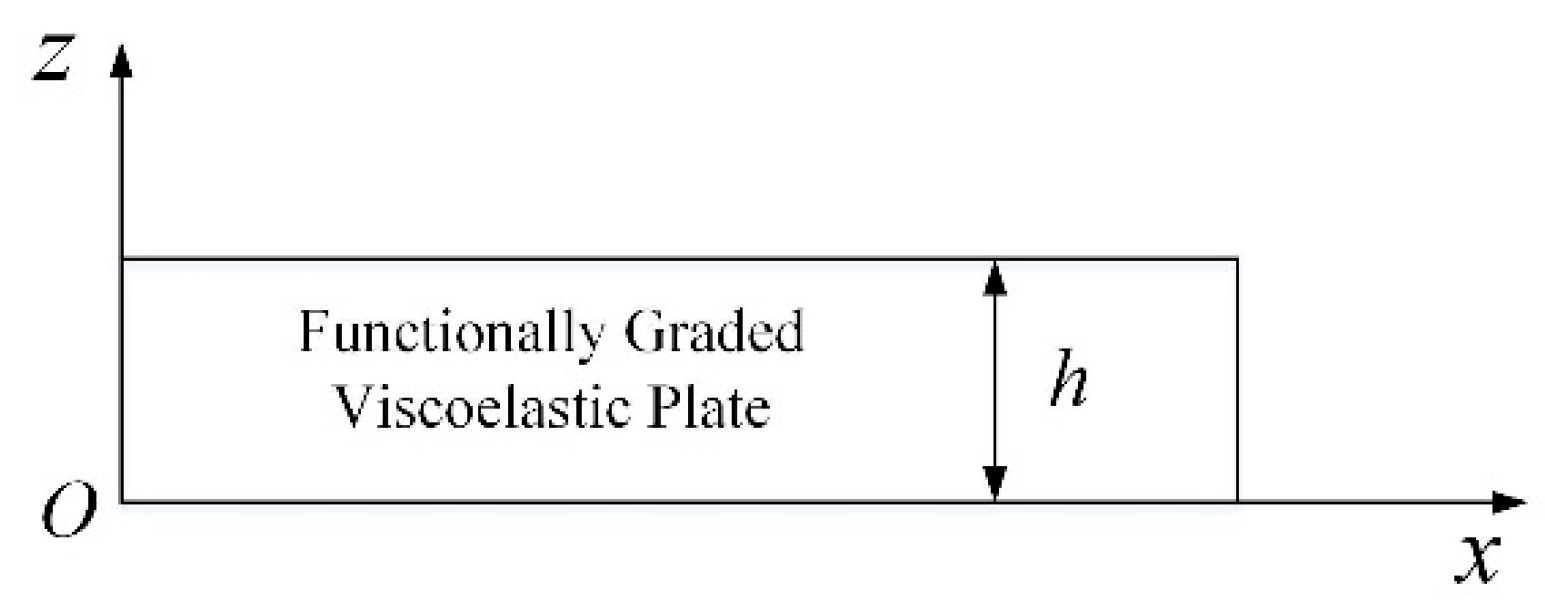
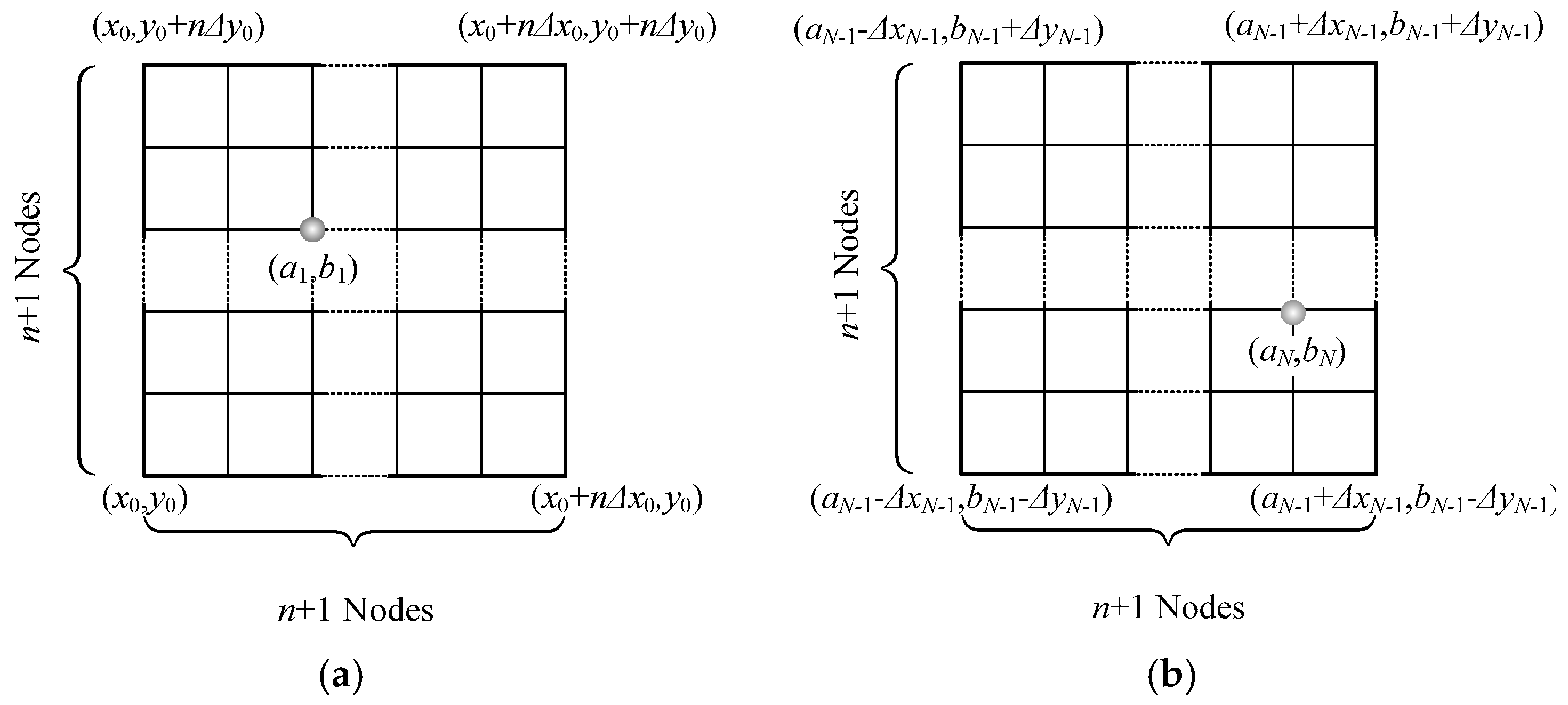
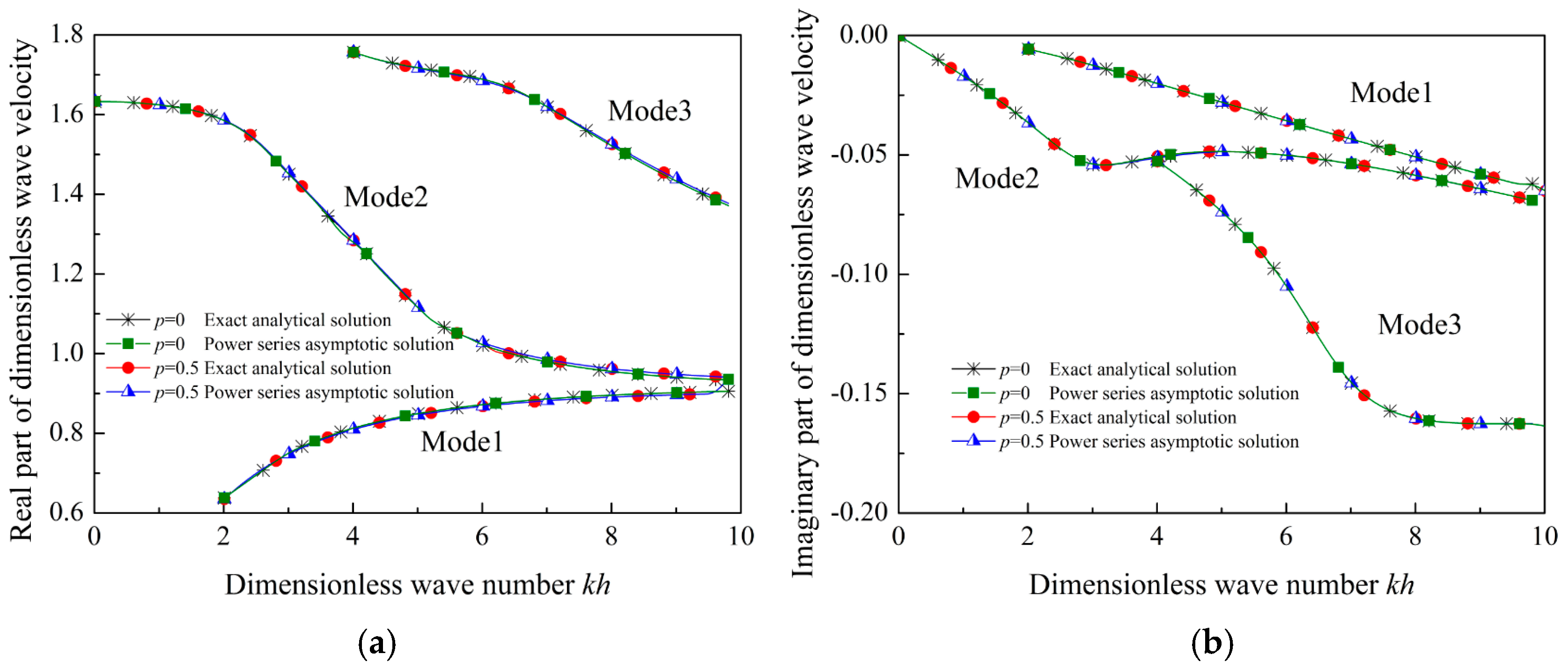
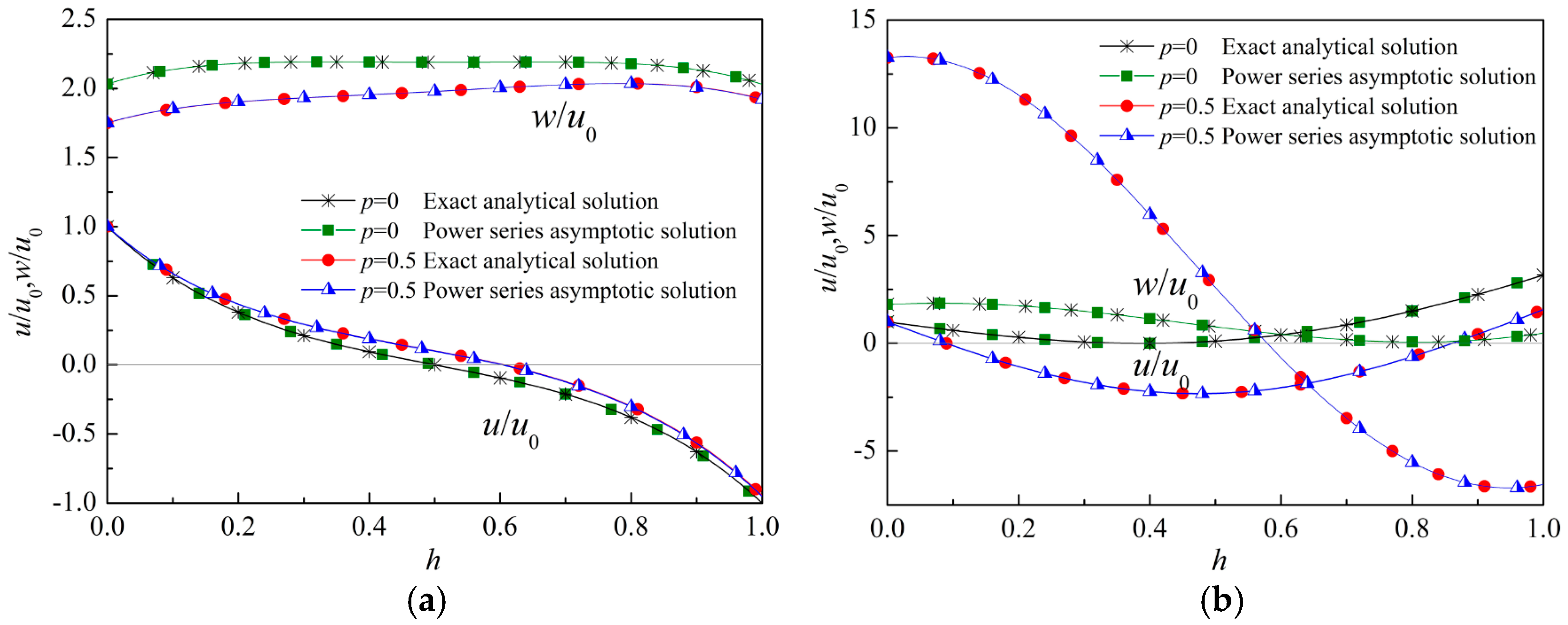
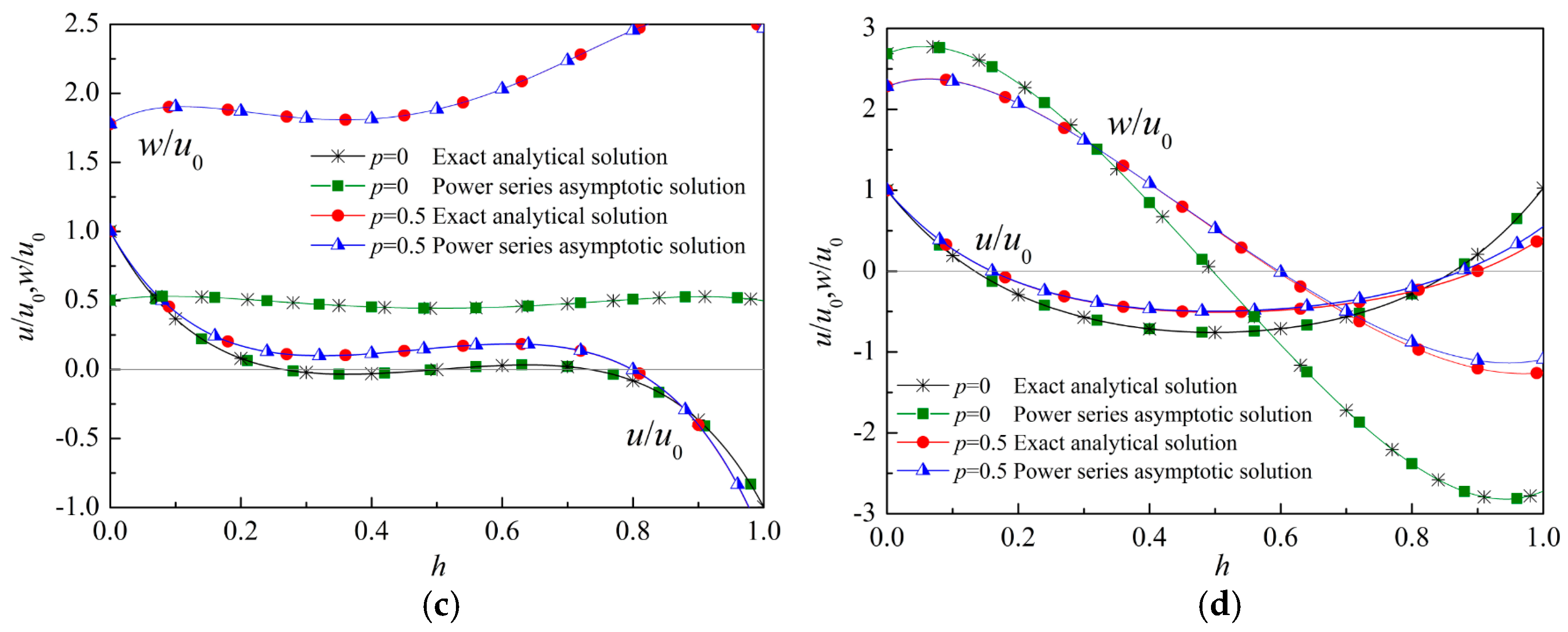
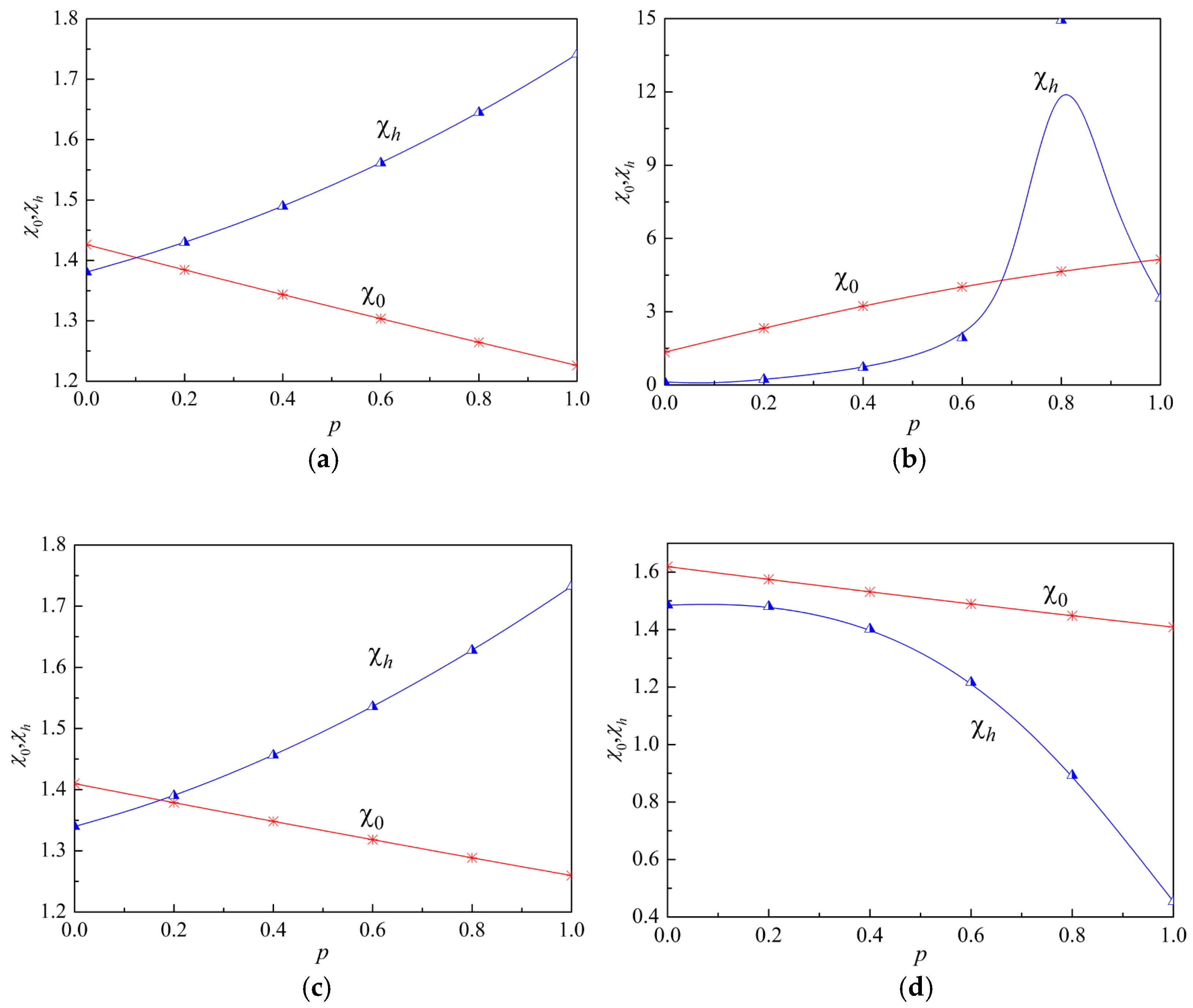

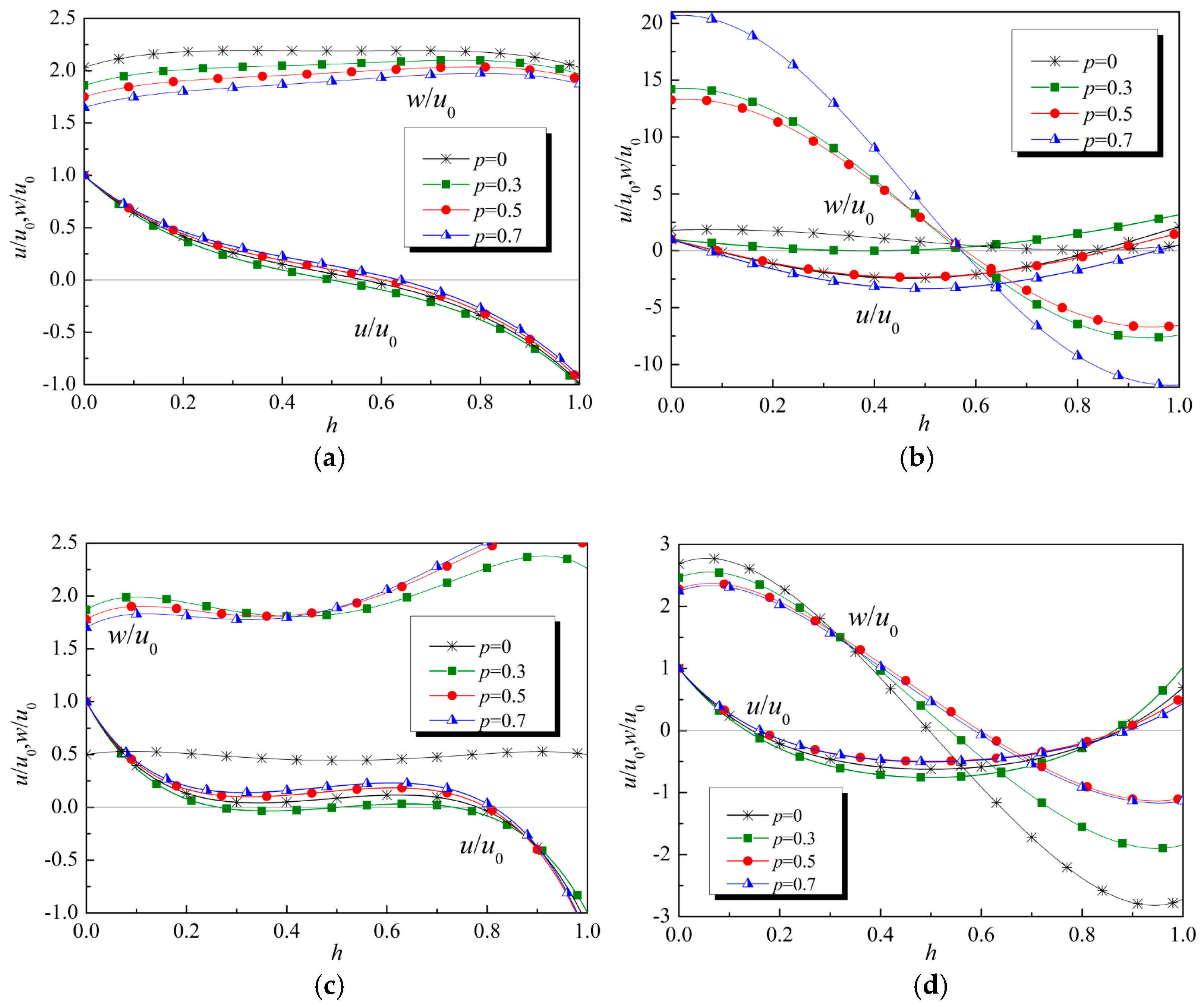
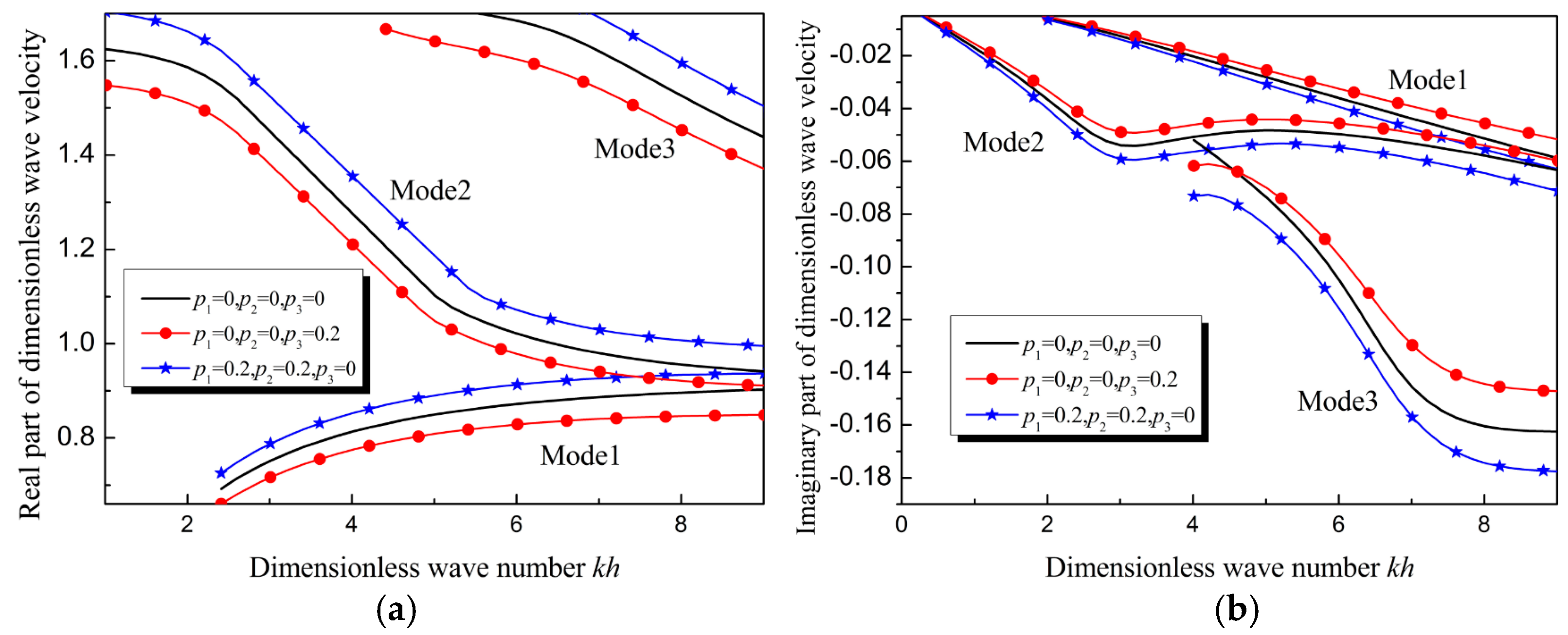
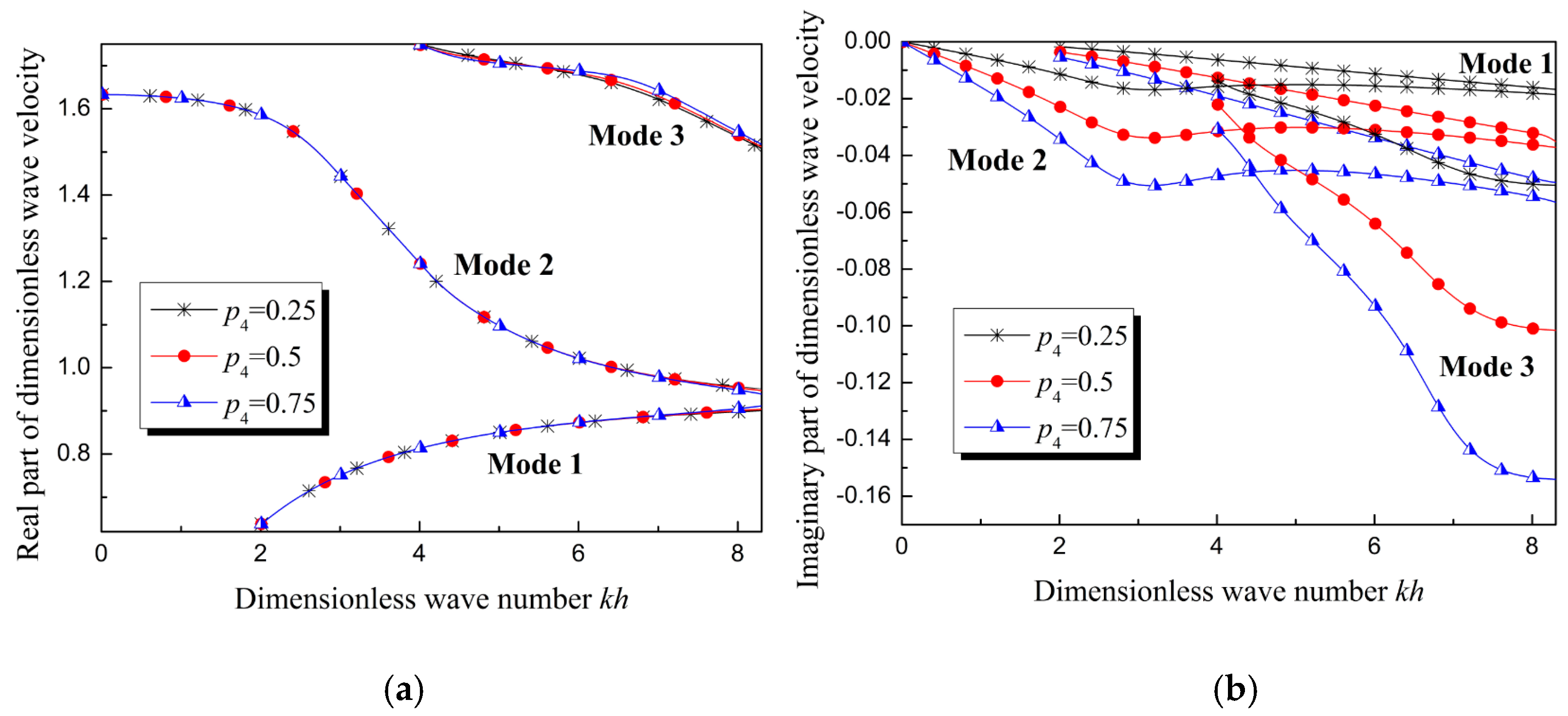
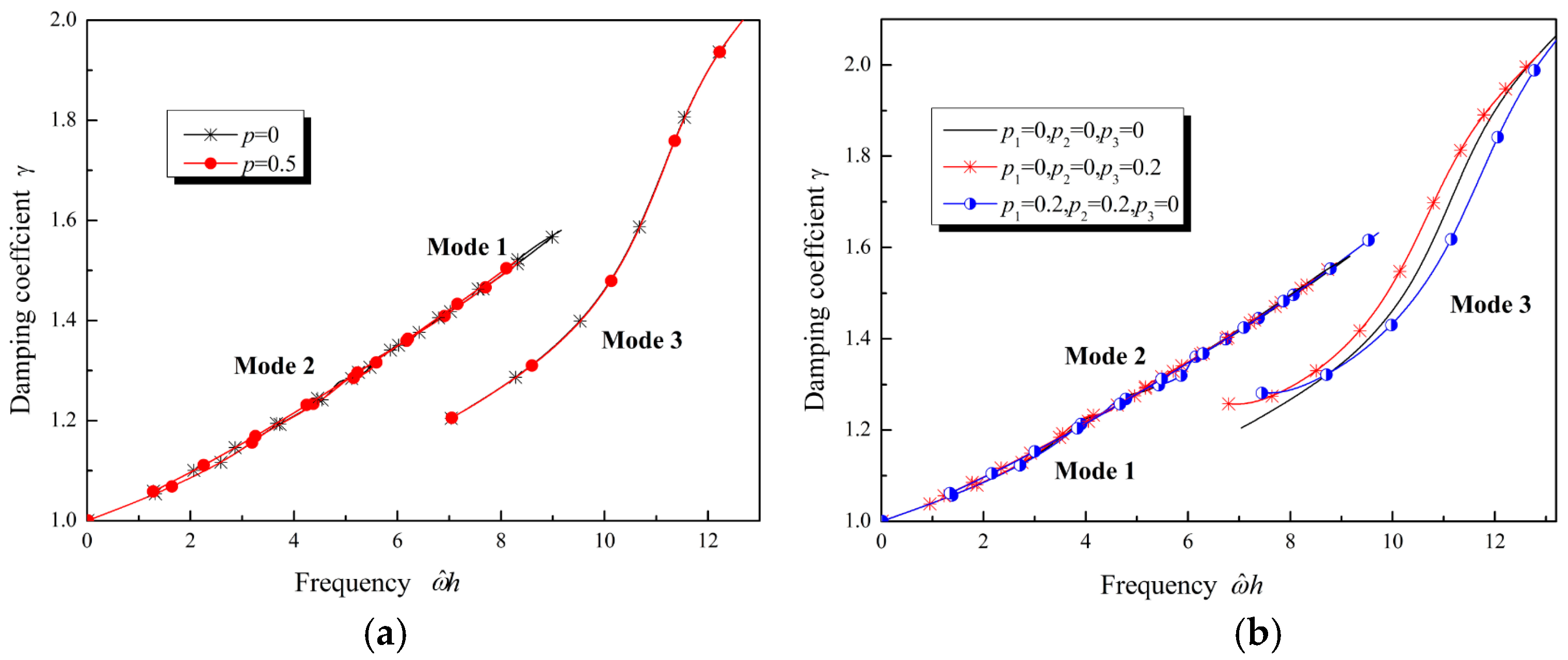

© 2019 by the authors. Licensee MDPI, Basel, Switzerland. This article is an open access article distributed under the terms and conditions of the Creative Commons Attribution (CC BY) license (http://creativecommons.org/licenses/by/4.0/).
Share and Cite
Cao, X.; Jiang, H.; Ru, Y.; Shi, J. Asymptotic Solution and Numerical Simulation of Lamb Waves in Functionally Graded Viscoelastic Film. Materials 2019, 12, 268. https://doi.org/10.3390/ma12020268
Cao X, Jiang H, Ru Y, Shi J. Asymptotic Solution and Numerical Simulation of Lamb Waves in Functionally Graded Viscoelastic Film. Materials. 2019; 12(2):268. https://doi.org/10.3390/ma12020268
Chicago/Turabian StyleCao, Xiaoshan, Haining Jiang, Yan Ru, and Junping Shi. 2019. "Asymptotic Solution and Numerical Simulation of Lamb Waves in Functionally Graded Viscoelastic Film" Materials 12, no. 2: 268. https://doi.org/10.3390/ma12020268




